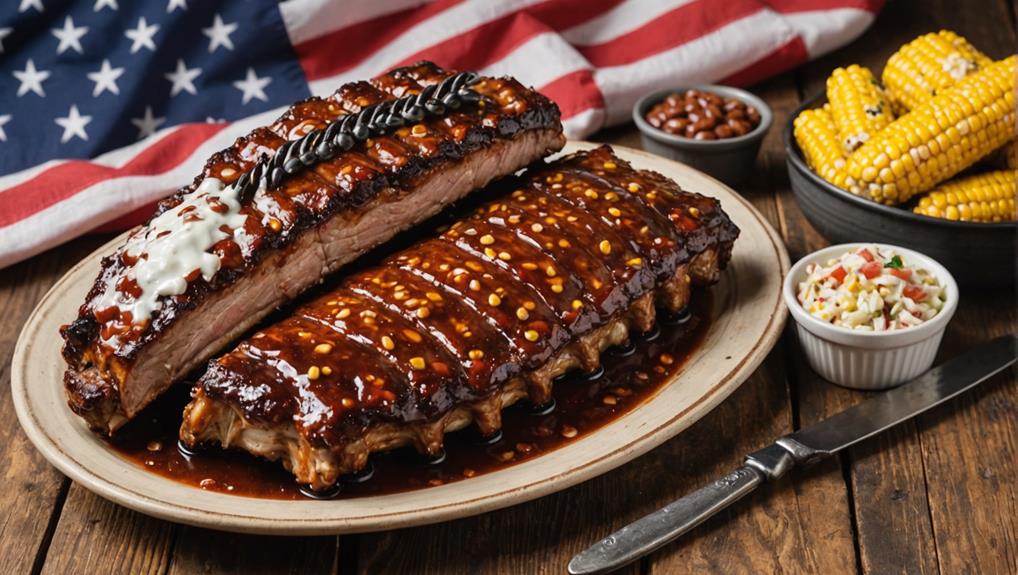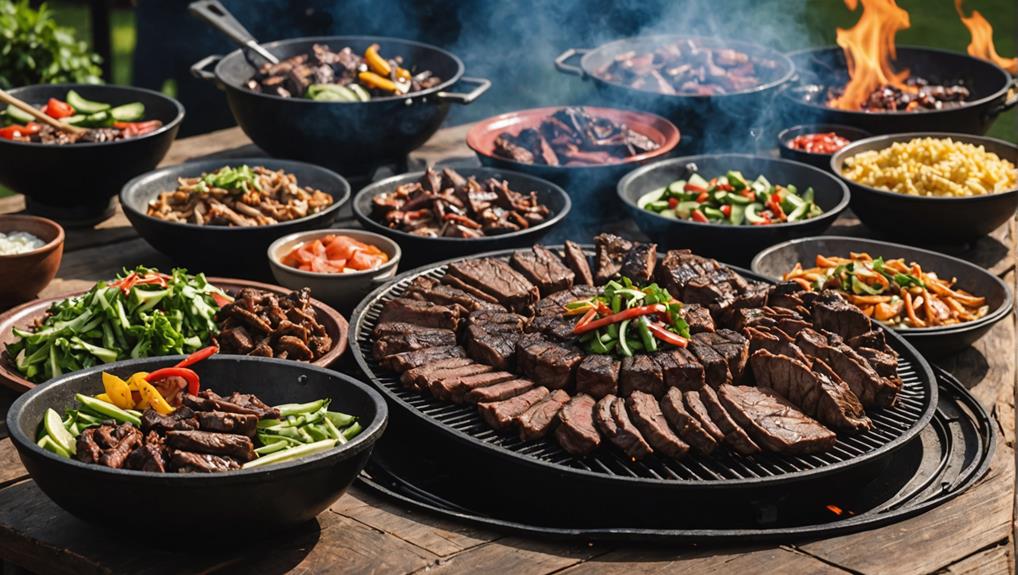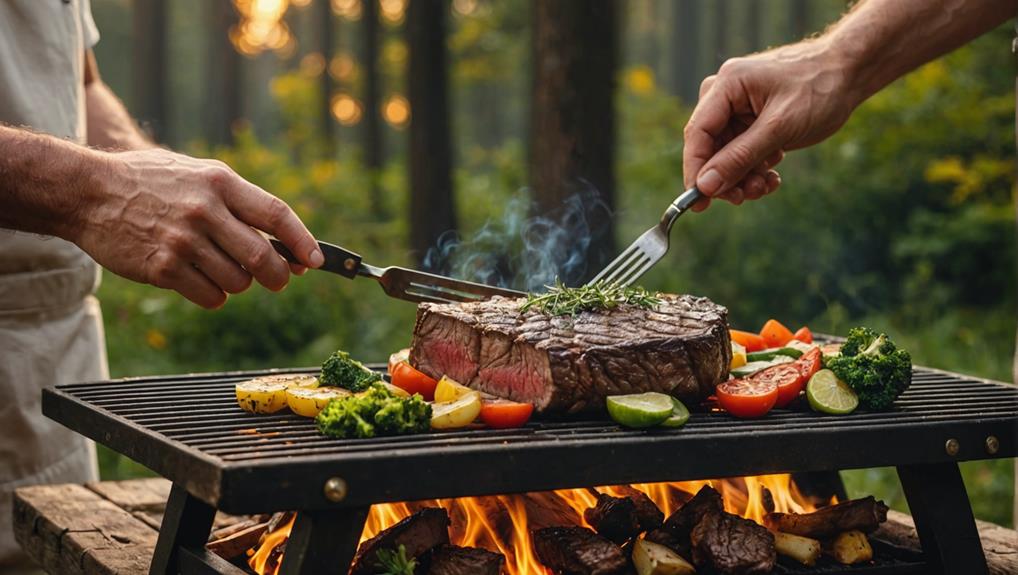To master America's regional BBQ delights, you'll need to explore diverse flavors and techniques. Start by familiarizing yourself with iconic styles like Kansas City's sweet, molasses-based sauces and North Carolina's tangy vinegar blends. Experiment with wood selection, pairing hickory with pork and mesquite with beef for authentic smokiness. Perfect your rubs and marinades, balancing spices to complement each meat. Master low-and-slow cooking methods, essential for developing deep flavors in brisket and pulled pork. Don't forget to study the legacies of renowned pit masters and participate in local competitions to hone your skills. The journey to BBQ mastery is rich with smoky secrets waiting to be uncovered.
Celebrating Diverse Flavors
A tapestry of flavors unfolds across America's BBQ landscape, showcasing the rich diversity of regional styles. As you explore the world of regional barbecue, you'll discover a mouthwatering array of sauces and techniques that define each area's unique approach. From Kansas City's thick, sweet sauces to North Carolina's tangy vinegar-based concoctions, every bite tells a story of culinary tradition.
To truly master America's barbecue styles, you'll need to understand the nuances of each region. Memphis BBQ, for instance, combines dry rubs with tomato-based sauces, creating a perfect balance of sweet and spicy flavors that elevate pulled pork and ribs.
In contrast, Texas BBQ often lets the meat's natural flavors shine, using minimal sauce in Central Texas while embracing thinner, ketchup-based sauces in the east.
These diverse techniques reflect the convergence of African American, Native American, and European influences, resulting in distinct flavor profiles across the country.
Saucy Renditions Across America
As you explore America's BBQ landscape, you'll encounter a rich tapestry of sauces that define regional flavors.
From Kansas City's sweet, molasses-infused concoctions to Eastern Carolina's tangy vinegar-based blends, each sauce tells a unique culinary story.
Understanding these distinct profiles and their iconic ingredients will help you pair sauces with the right meats, enhancing your BBQ experience and deepening your appreciation for this beloved American tradition.
Regional Sauce Flavor Profiles
From coast to coast, America's regional BBQ sauces offer a tantalizing tour of flavors that reflect local culinary traditions.
You'll discover a rich tapestry of taste as you explore the diverse sauce profiles that define each region's barbecue identity. In the Carolinas, you'll encounter two distinct styles: Eastern Carolina's tangy vinegar-based sauce, perfect for whole hog barbecue, and South Carolina's unique mustard-based Carolina Gold, adding zest to smoked meats.
Venture to Kansas City, and you'll find thick, sweet sauces often featuring molasses or brown sugar, complemented by a hint of liquid smoke.
Memphis barbecue presents a balance of dry rubs and sweet, tomato-based sauces, emphasizing pulled pork and ribs.
In contrast, Texas BBQ, particularly in the central region, focuses on the meat's quality and spice rubs, using minimal sauce.
However, East Texas adopts thinner, ketchup-based sauces that are less sweet than their Kansas City counterparts.
Iconic Sauce Ingredients
Every region's signature barbecue sauce boasts unique ingredients that define its character. As you explore the world of regional styles, you'll discover a rich tapestry of flavors that set each sauce apart.
In Kansas City, you'll find molasses and brown sugar creating a thick, sweet profile, while Eastern Carolina relies on the simplicity of vinegar and red pepper flakes. Memphis-style barbecue combines a dry rub with a sweet, tomato-based sauce, balancing spices and sugars.
To truly appreciate the diversity of barbecue sauces across America, consider these iconic ingredients:
- Molasses: Adds depth and sweetness to Kansas City-style sauces
- Vinegar: Forms the tangy base of Eastern Carolina sauces
- Mustard: The key component in South Carolina's Carolina Gold sauce
- Tomato: A common base in many regional styles, including Memphis and Texas
- Liquid smoke: Enhances the smoky flavor in Kansas City sauces
Sauce Pairing Techniques
The art of pairing sauces with barbecued meats elevates your BBQ experience to new heights. As a barbecue enthusiast, you'll want to master the regional nuances of sauce pairing to truly unlock the potential of your smoky creations.
Start by exploring Kansas City's sweet, thick sauces, perfect for slathering on ribs and burnt ends. The molasses or brown sugar base complements the meat's richness, creating a harmonious flavor profile.
For a tangy twist, turn to Eastern Carolina's vinegar-based sauce. Its acidity cuts through the fattiness of whole hog barbecue, balancing the dish beautifully.
In Memphis, you'll find tomato-based sauces that enhance dry-rubbed ribs and pulled pork, adding depth to the city's bold flavors. Don't overlook South Carolina's mustard-based Carolina Gold sauce, which pairs exceptionally well with pulled pork, offering a zesty kick to each bite.
When tackling Texas-style BBQ, remember that less is often more. Central Texas brisket shines with minimal sauce, relying on salt and pepper rubs to accentuate the meat's natural flavors.
Smoke Signals: Wood Selection
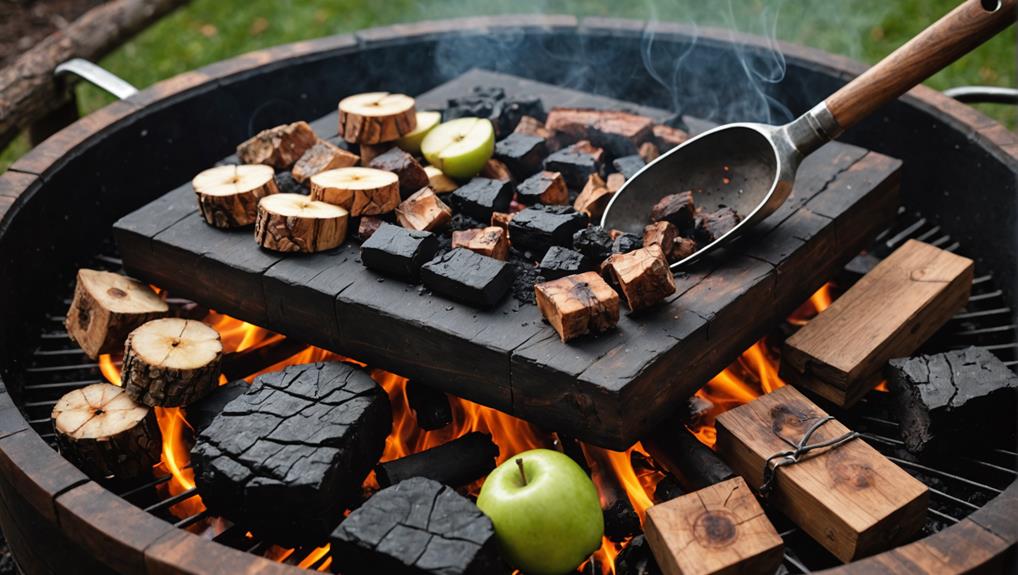
When you're choosing wood for smoking meats, you're not just selecting fuel; you're picking a key ingredient that'll shape your barbecue's flavor profile.
Different woods impart unique tastes, from hickory's bold smokiness to applewood's subtle sweetness, and each region of the United States has its preferred varieties based on local availability and traditional practices.
To master the art of wood selection, you'll need to understand how to pair specific woods with different meats, considering factors like burn rate and intensity to achieve the perfect balance of smoke and flavor in your barbecue creations.
Flavor Profiles of Woods
Selecting the right wood for your BBQ can elevate your smoked meats from good to extraordinary. Each wood type imparts unique flavor profiles, transforming your barbecue into a culinary adventure.
Here's a guide to help you navigate the world of smoking woods:
- Hickory: Delivers a strong, bacon-like taste
- Apple wood: Offers a sweet, fruity profile ideal for poultry and pork
- Mesquite: Provides a bold flavor best for beef, especially brisket
- Oak: Produces a versatile medium to strong flavor for longer smokes
- Cherry: Adds a mild, sweet flavor and rich color to meats
To innovate your BBQ techniques, consider mixing woods for complex flavor layering. For instance, combining apple and hickory creates a nuanced taste that'll impress even the most discerning palates.
When smoking beef, opt for mesquite's intense flavor, but use it sparingly to avoid overpowering the meat.
For versatility, oak's medium-strong profile pairs well with various meats, making it perfect for longer smoking sessions.
Cherry wood's mild sweetness works wonders with poultry and ribs, often complemented by stronger woods for depth.
Regional Wood Preferences
Just as each wood imparts its unique flavor, different regions across the United States have developed distinct preferences for smoking woods, creating a rich tapestry of barbecue traditions.
In Texas, oak reigns supreme, offering a robust heat and flavor that's perfect for their bold beef-centric style. You'll find hickory dominating the pits in North Carolina, where its sweet, rich smoke enhances the region's beloved pork dishes.
As you venture into the Midwest, you'll discover a preference for fruitwoods like apple and cherry. These milder options complement ribs and chicken without overpowering their natural flavors.
In Central Texas, mesquite wood takes center stage, delivering an intense flavor that pairs exceptionally well with brisket. However, use it sparingly to avoid overwhelming your meat.
Southern barbecue regions, particularly South Carolina, opt for a balanced approach by combining oak with fruitwoods. This clever mix complements their signature vinegar-based sauces.
Wood Pairing Techniques
Every pitmaster knows that the secret to exceptional barbecue lies in the artful selection and combination of smoking woods. To elevate your BBQ game, you'll need to master wood pairing techniques that create harmonious smoky flavors.
By combining different woods, you can achieve a depth of flavor that's impossible with a single type. For instance, try mixing oak's robust profile with cherry's subtle sweetness for a well-rounded brisket smoke.
Consider these innovative wood pairing techniques to enhance your barbecue:
- Blend hickory and apple for a balanced pork shoulder
- Combine mesquite and pecan for a bold, nutty beef flavor
- Pair maple and cherry for a sweet, mild poultry smoke
- Mix oak and peach for a fruity, complex rib profile
- Layer post oak and hickory for a traditional Texas-style brisket
When experimenting with wood combinations, start with a 70/30 ratio of your primary to secondary wood. This approach allows you to maintain the dominant flavor while introducing complementary notes.
Fuel for Flavor: Regional Preferences
Across the United States, you'll find a rich tapestry of barbecue traditions, each region boasting its own unique flavor profile. As you explore the diverse barbecue scene, you'll discover that regional preferences play a crucial role in shaping the taste and style of sauces and rubs.
In Kansas City, you'll encounter sweet, thick molasses-based sauces that cling to the meat, while Eastern Carolina offers a tangy kick with vinegar and red pepper flakes.
Memphis barbecue enthusiasts pride themselves on dry rubs, complemented by sweet, tomato-based sauces that add depth to the flavor profile. St. Louis takes a different approach, preparing pork spare ribs without liquid smoke and pairing them with distinctive sauces like Maull's.
Venture to South Carolina, and you'll experience the mustard-based Carolina Gold sauce and vinegar-heavy Lexington Dip.
Texas barbecue varies by region, with Central Texas focusing on expertly smoked brisket with minimal sauce, while East Texas opts for thinner, ketchup-based sauces.
Seasoned Traditions: Rubs and Marinades
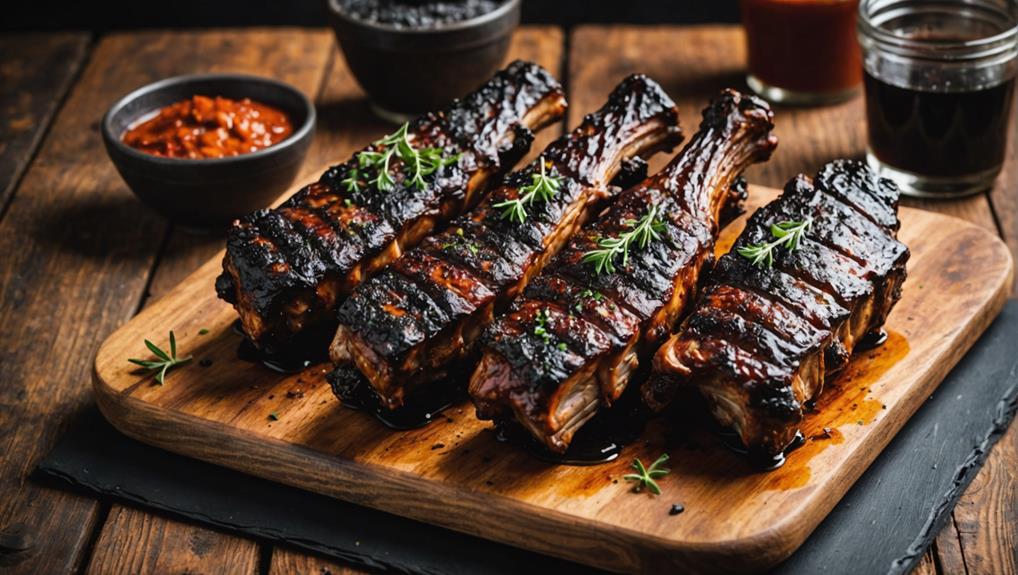
At the heart of every great barbecue lies the secret weapon of pitmasters: rubs and marinades. These flavor enhancers are the cornerstone of regional BBQ styles, each reflecting unique culinary traditions.
You'll find that dry rubs often include a blend of spices like paprika, garlic powder, onion powder, and cayenne pepper, creating distinctive taste profiles. Much like the balance of flavors in Coconut Curry Shrimp, mastering BBQ techniques requires attention to how different spices interact.
To master regional BBQ flavors, consider these key points:
- Kansas City's sweet rubs feature brown sugar, complementing thick, molasses-based sauces.
- Eastern North Carolina relies on simple vinegar-based marinades for natural meat flavors.
- Texas BBQ emphasizes salt and black pepper rubs, letting quality beef shine.
- Marinating meats overnight significantly improves flavor absorption.
- Dry rubs enhance flavor profiles distinctive to various regional styles.
You'll want to experiment with different combinations to achieve authentic regional tastes.
In Kansas City, you'll use sweeter rubs, while in Texas, you'll focus on salt and pepper to highlight the beef's quality. For Eastern North Carolina-style BBQ, opt for vinegar-based marinades that won't overpower the meat's natural flavors.
Regional Ingredients: Local Tastes
As you explore regional BBQ styles, you'll discover how local ingredients shape unique flavor profiles across the country.
From hickory-smoked meats in the Carolinas to mustard-based sauces in South Carolina, each area's culinary heritage is reflected in its BBQ traditions.
You'll find that these regional specialties not only showcase local produce and agricultural practices but also tell a story of the area's history and cultural influences.
Unique Regional Flavor Profiles
The tapestry of American BBQ is woven with distinct regional flavors, each telling a unique story of local ingredients and culinary traditions.
As you explore the world of BBQ, you'll encounter a diverse range of flavor profiles that reflect the rich heritage of different regions. From the sweet and thick Kansas City sauces to the tangy vinegar-based concoctions of Eastern Carolina, each style offers a unique taste experience.
To truly appreciate the unique regional flavor profiles, consider these key elements:
- Sweetness: Kansas City's molasses and brown sugar-infused sauces
- Acidity: Eastern Carolina's vinegar-based sauces with red pepper flakes
- Tomato base: Western North Carolina's Lexington-style BBQ
- Mustard: South Carolina's distinctive Carolina Gold sauce
- Minimalism: Central Texas' salt and pepper rubs
Local Produce Influences
Exploring regional BBQ flavors reveals a deep connection to local produce and ingredients. You'll find that each area's unique taste profile is shaped by what's grown nearby.
In South Carolina, the tangy Carolina Gold sauce gets its distinctive flavor from local mustard, while Northeast BBQ enthusiasts swear by apple wood for smoking, imparting a subtle fruity essence.
Western North Carolina's BBQ scene showcases the region's abundant hickory forests, using this wood to create a rich smokiness that perfectly complements vinegar-based sauces.
In Texas, you'll encounter beef-centric BBQ that celebrates the state's cattle ranching heritage, with brisket taking center stage.
Don't overlook the seasonal produce that accompanies these smoky delights. Collard greens in the Carolinas and corn dishes in Kansas City highlight the integration of local agriculture.
To truly appreciate these regional differences, attend BBQ festivals where you'll find competition categories encouraging the use of indigenous spices and herbs.
These events not only promote local cooking styles but also emphasize the importance of regional ingredients in creating authentic BBQ experiences.
Heritage Ingredients Spotlight
Regional BBQ traditions celebrate heritage ingredients that have shaped local tastes for generations. As you explore American Barbecue, you'll discover how these ingredients create unique flavor profiles across different regions.
In the heritage ingredients spotlight, you'll find that each area's culinary identity is deeply rooted in its local resources.
To truly appreciate the diversity of regional BBQ, consider these key heritage ingredients:
- Hickory wood in Western North Carolina
- Mustard varieties in South Carolina
- Apple cider vinegar in Eastern North Carolina
- Molasses and brown sugar in Kansas City
- Mesquite wood in Texas
These ingredients aren't just flavoring agents; they're a testament to each region's agricultural legacy.
You'll notice how Western North Carolina's hickory-smoked meats differ from Texas's mesquite-infused brisket. The tangy kick of Eastern North Carolina's vinegar-based sauce contrasts sharply with Kansas City's sweet, thick concoctions.
Mastering the Craft: Cooking Techniques

Mastering the art of barbecue requires a deep understanding of various cooking techniques.
You'll need to familiarize yourself with smoking, grilling, rotisserie, and braising methods to elevate your BBQ game.
Smoking, the cornerstone of American barbecue, involves low and slow cooking at 225°F to 275°F, infusing meats with rich, smoky flavors over several hours.
For quicker results, grilling utilizes high heat above 400°F, creating a distinctive char and sear while preserving moisture.
To tackle larger cuts, rotisserie cooking ensures even cooking and juicy results by rotating the meat on a spit.
For tougher cuts, braising combines low-temperature wet cooking methods, simmering meat in flavorful liquids to achieve tenderness.
To truly innovate your barbecue, master the art of spice rubs.
Experiment with ingredients like paprika, garlic powder, and cayenne pepper to create unique flavor profiles that complement your chosen cooking technique.
Pit Masters and Their Legacy
While mastering techniques is vital, the true spirit of barbecue lies in the pit masters who've shaped its legacy. These culinary artists have transformed their passion into a craft, influencing regional styles and inspiring future generations.
You'll find that many pit masters, like Aaron Franklin, have become cultural icons, revolutionizing traditions and elevating barbecue to new heights.
To join the ranks of these smoke-wielding maestros, consider these pathways:
- Hone your skills through years of practice and experimentation
- Participate in events like the Championship Barbecue Cooking Contest
- Enroll in programs like BBQ Champs Academy for expert guidance
- Compete in prestigious competitions sanctioned by the Kansas City Barbecue Society
- Support preservation initiatives like the Campaign for Real Barbecue
As you embark on your pit master journey, remember that success often comes from a blend of tradition and innovation.
You'll need to master time-honored techniques while also developing your unique flavor profiles. By studying the greats and participating in competitions, you'll not only improve your skills but also contribute to the rich tapestry of American barbecue culture, ensuring its legacy continues for generations to come.
The Art of Slow and Low
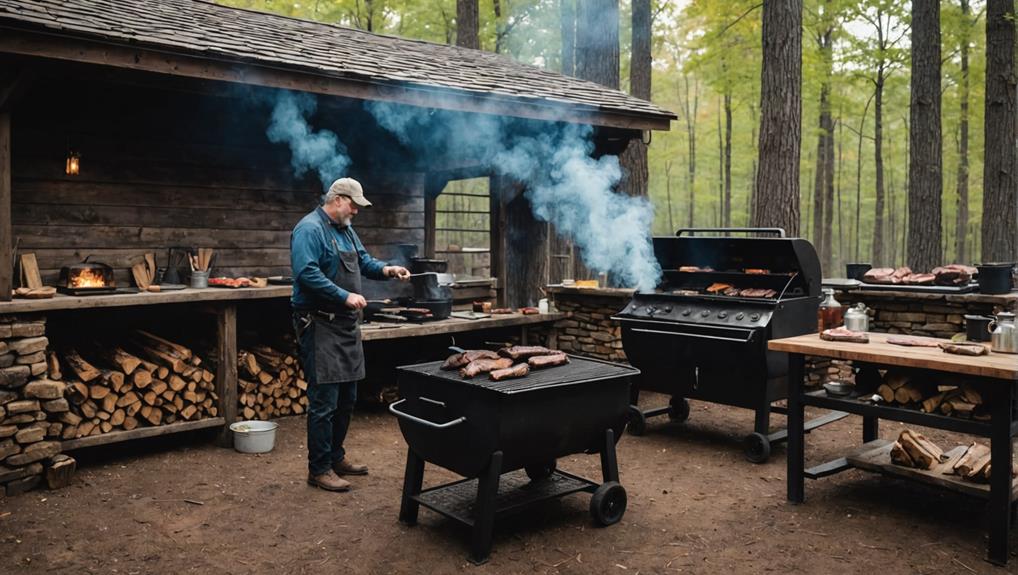
At the heart of great barbecue lies the art of "slow and low" cooking. You'll find that this technique involves maintaining temperatures between 225°F and 275°F for extended periods, often exceeding 12 hours for tougher cuts like brisket and pork shoulder. This method breaks down collagen, resulting in moist, succulent slow-cooked meats with a robust smokiness.
To master this technique, you'll need to understand the interplay of factors like humidity, air flow, and meat fat content. These elements influence cooking times and flavor development.
You'll also want to experiment with different wood types, such as hickory, mesquite, and apple, each imparting unique flavor profiles to enhance your barbecue.
Precise timing is critical in "slow and low" cooking. You'll rely on meat thermometers to ensure internal temperatures reach safe levels, typically 195°F to 205°F for pulled pork.
This attention to detail, combined with patience and knowledge, will elevate your barbecue game. By mastering the art of "slow and low," you'll create tender, flavorful meats that showcase the true essence of traditional barbecue techniques.
Barbecue Festivals and Competitions
Barbecue festivals and competitions ignite the passion of pitmasters and food enthusiasts alike across the United States. These events offer you a unique opportunity to experience the best in barbecue culture, from mouthwatering flavors to innovative cooking techniques.
The World Championship Barbecue Cooking Contest in Memphis kicks off the season in May, featuring over 250 teams vying for the coveted Grand Champion title.
As a barbecue lover, you'll find plenty to explore at these events:
- Taste regional barbecue styles from across the country
- Watch live cooking demonstrations by expert pitmasters
- Enjoy live music and entertainment
- Sample free barbecue from numerous vendors
- Witness intense competition among top barbecue teams
From Washington, DC's Giant National Capital Barbecue Battle in June to Chicago's Windy City Smokeout in July, you'll have ample opportunities to immerse yourself in barbecue culture.
Don't miss the invitation-only Jack Daniels World Championship Invitational Barbecue in Lynchburg, TN, where state qualifiers compete for top honors.
The season culminates with The American Royal in Kansas City, MO, featuring over 600 teams and strict judging standards. These festivals showcase the innovation and passion driving America's barbecue scene, offering you a chance to expand your culinary horizons.
Frequently Asked Questions
What Is the Oldest Barbecue Sauce in America?
You'll find the oldest barbecue sauce in America's Eastern Carolina region. This vinegar-based concoction, steeped in barbecue history, has shaped sauce evolution since the 19th century. It's a tangy blend that's revolutionized whole hog barbecue traditions.
What Makes North Carolina Barbecue Sauce Different?
You'll taste the tang, feel the heat, and savor the tradition. North Carolina's BBQ sauce stands out with its vinegar-based Eastern style and tomato-infused Western style. It's a bold departure from mustard-based sauces, innovating flavor profiles.
What Is the Difference Between Memphis and Kansas City BBQ Sauce?
You'll find Memphis flavor leans towards tangy, vinegar-forward sauces with dry rub emphasis, while Kansas City cooking boasts thick, sweet, molasses-rich sauces. Memphis keeps it light; KC pours it on. Innovate by blending these distinct styles!
What Makes Kansas City Barbecue Sauce Different?
You'll find Kansas City barbecue sauce stands out with its sweet versus savory profile. It's built on a tomato base, enriched with molasses or brown sugar. You'll taste a perfect balance of thickness, smokiness, and tangy-sweet innovation.
Final Thoughts
You've embarked on a flavor-packed journey through America's barbecue landscape, uncovering secrets that'll transform you into a pit master extraordinaire. Armed with knowledge of regional sauces, wood selections, and time-honored techniques, you're now ready to create smoky masterpieces that'll make your taste buds dance with joy. Remember, true barbecue isn't just cooking; it's an art form that demands patience, passion, and practice. So fire up that grill, and let your newfound expertise shine through every perfectly smoked morsel.

